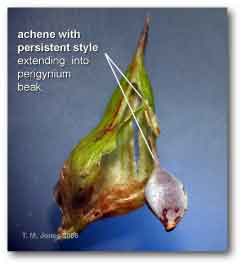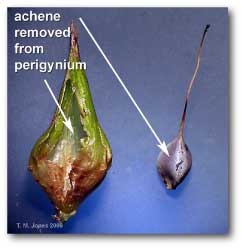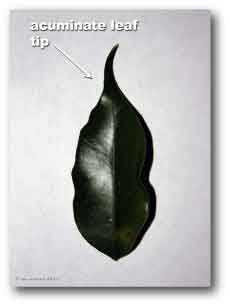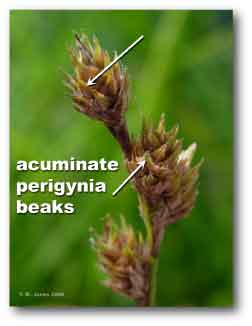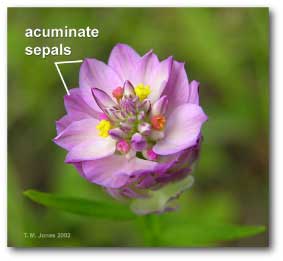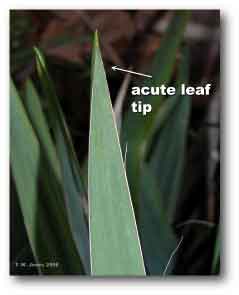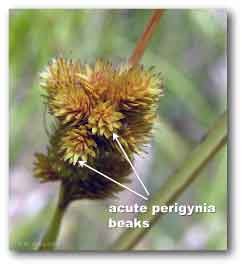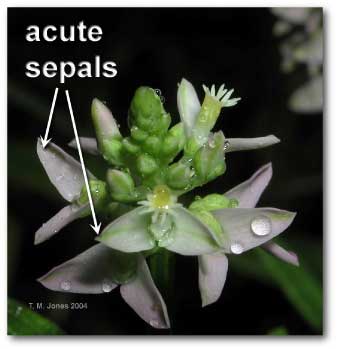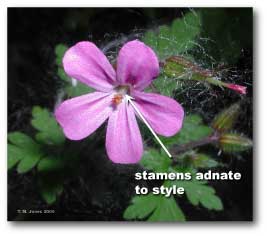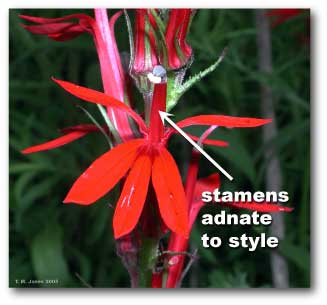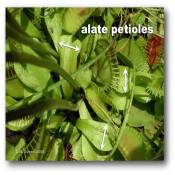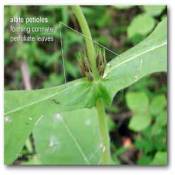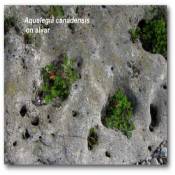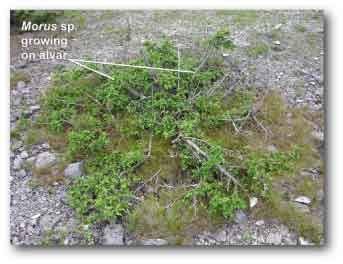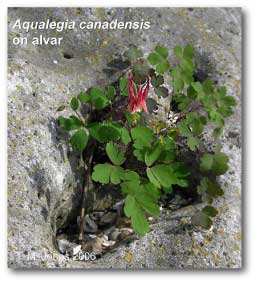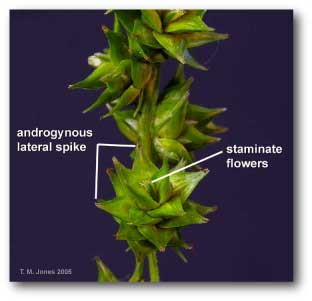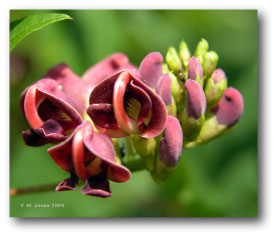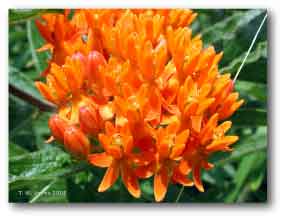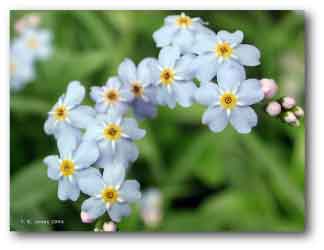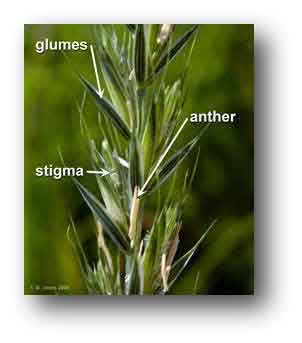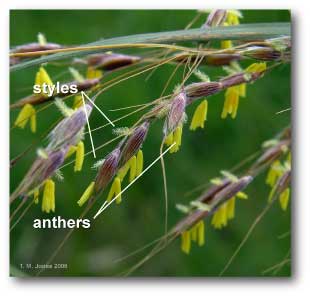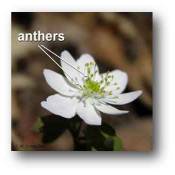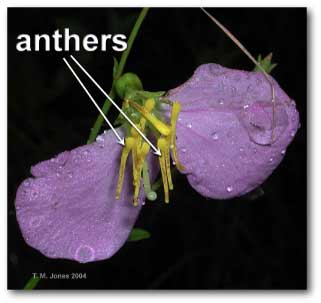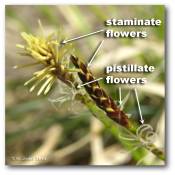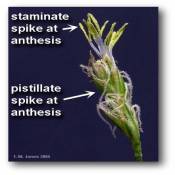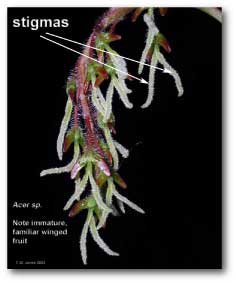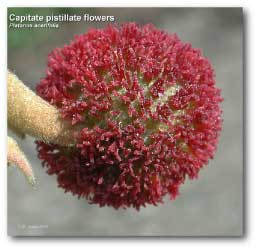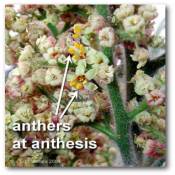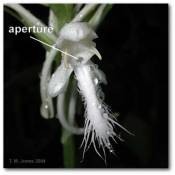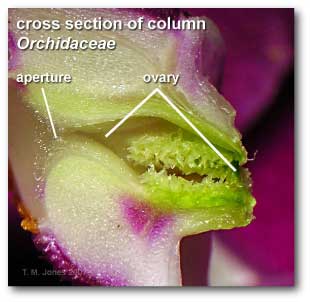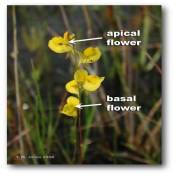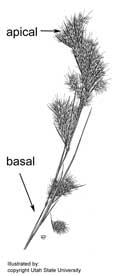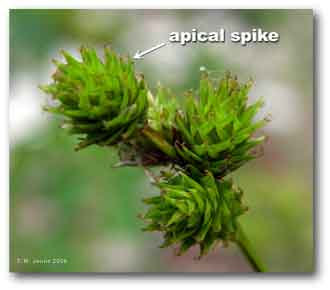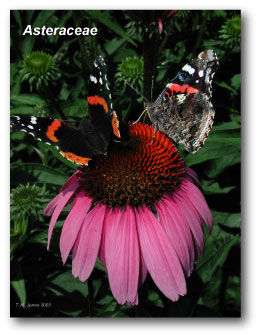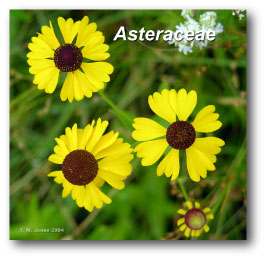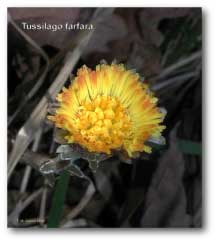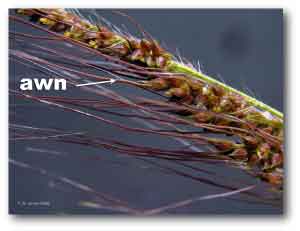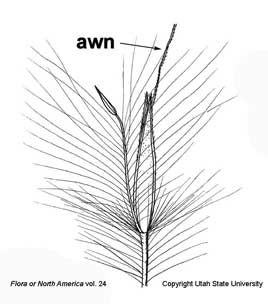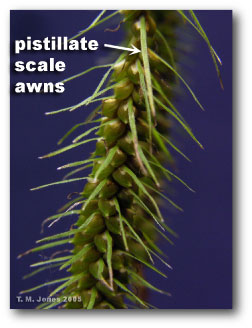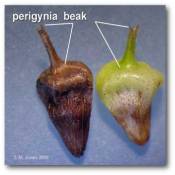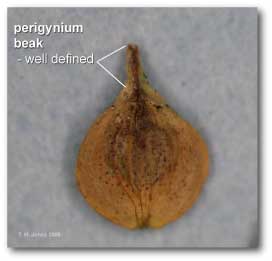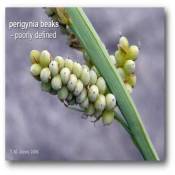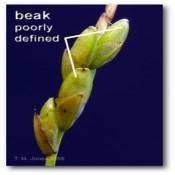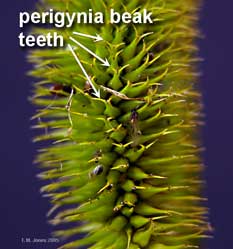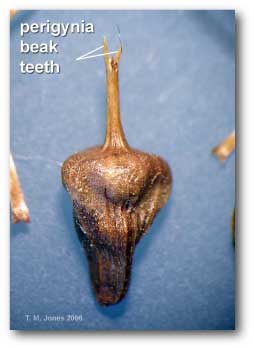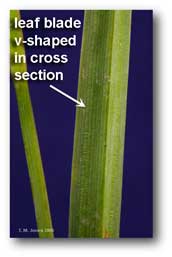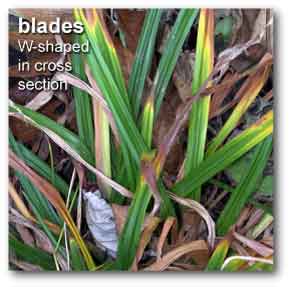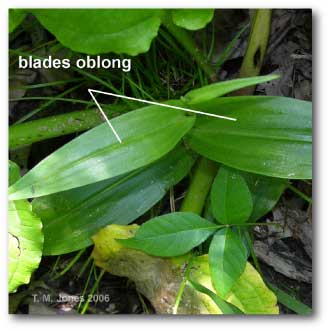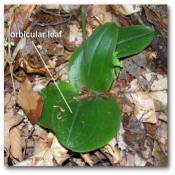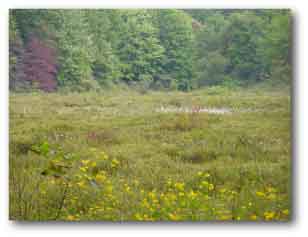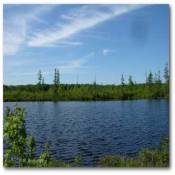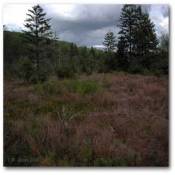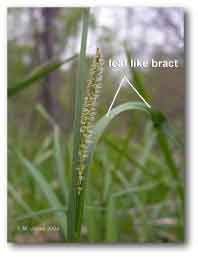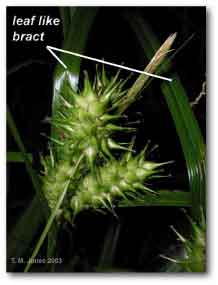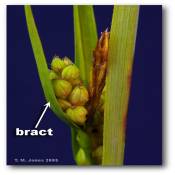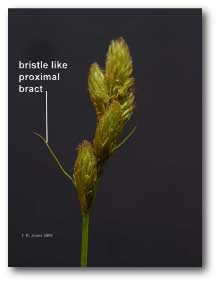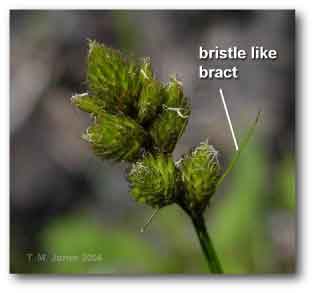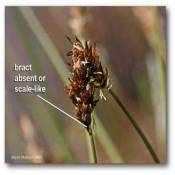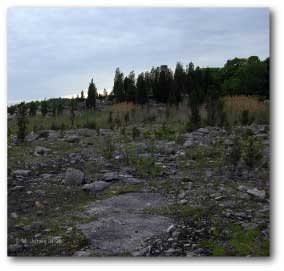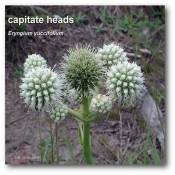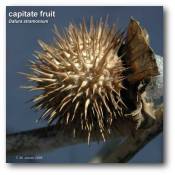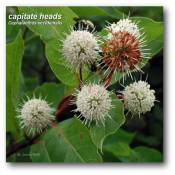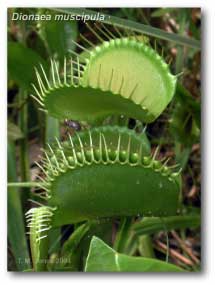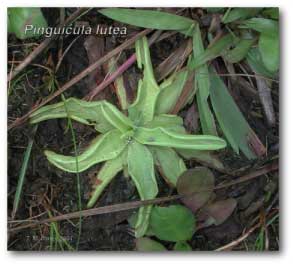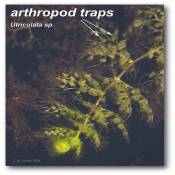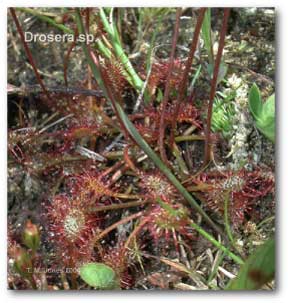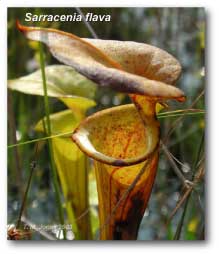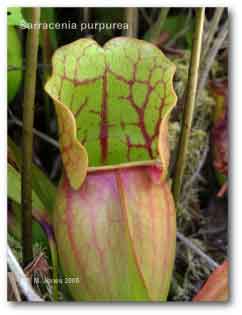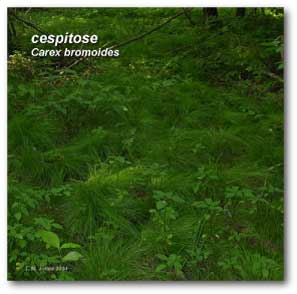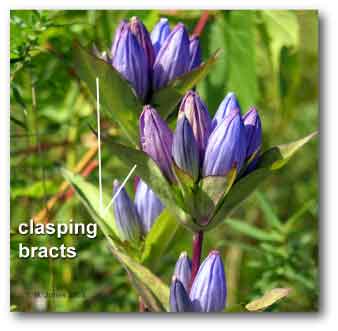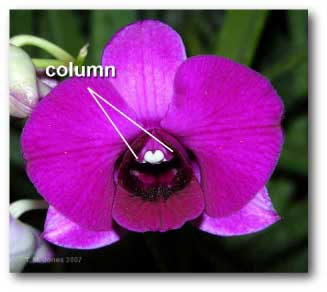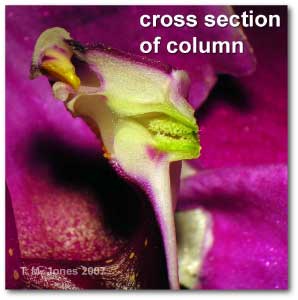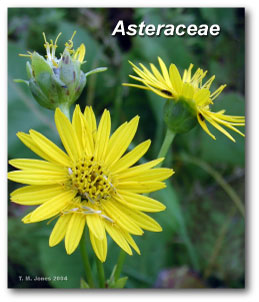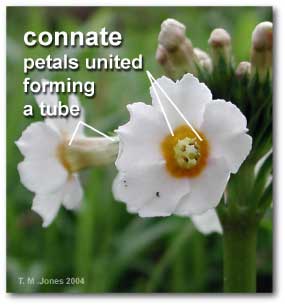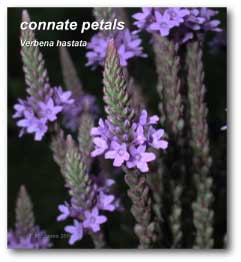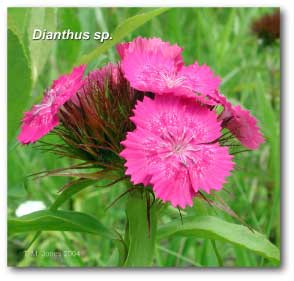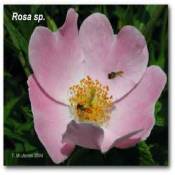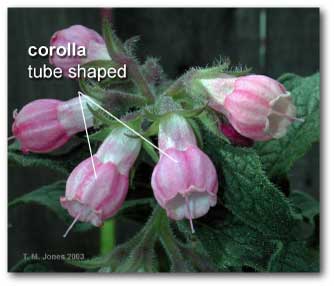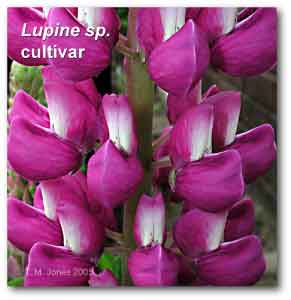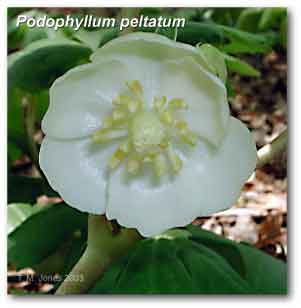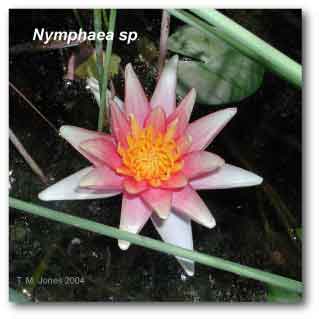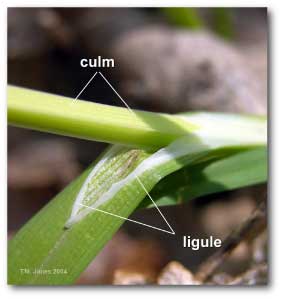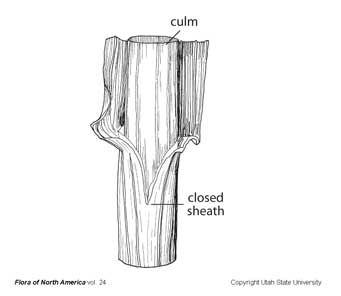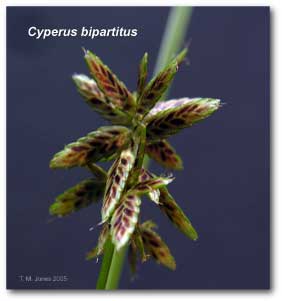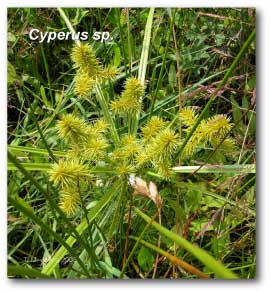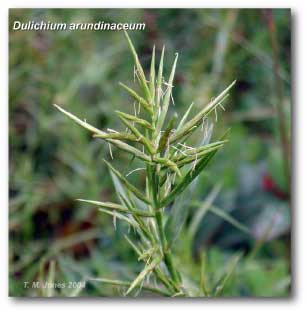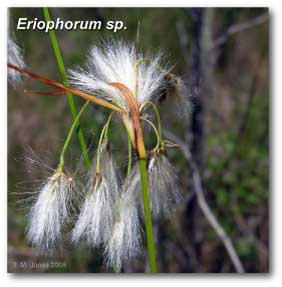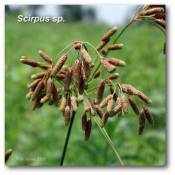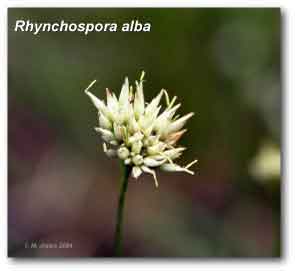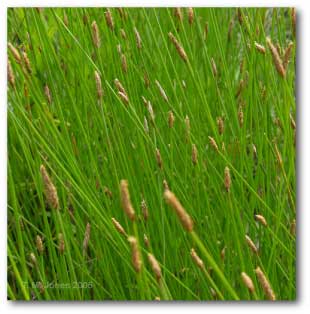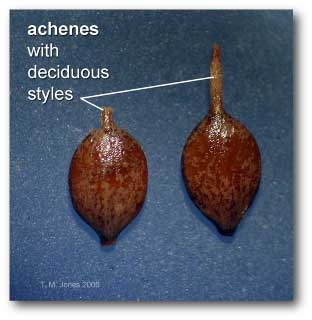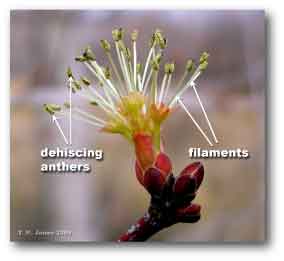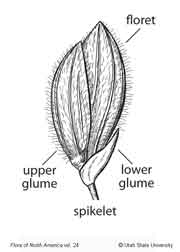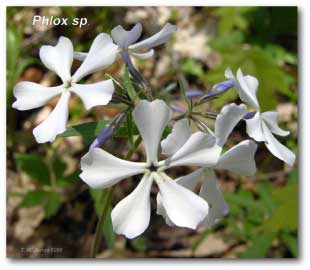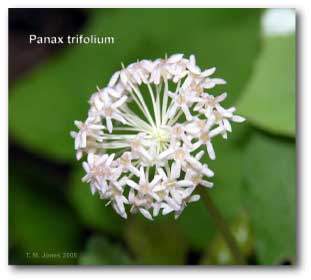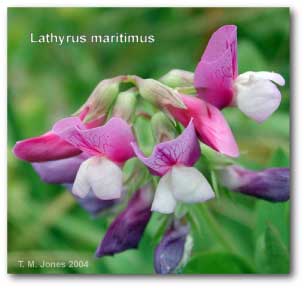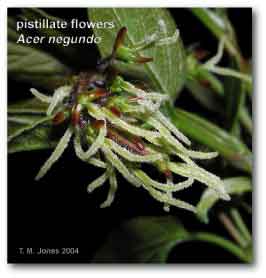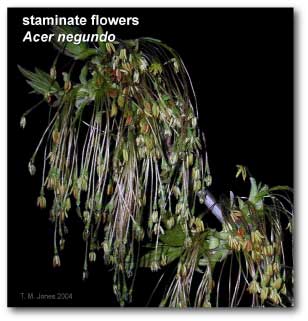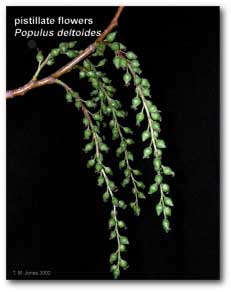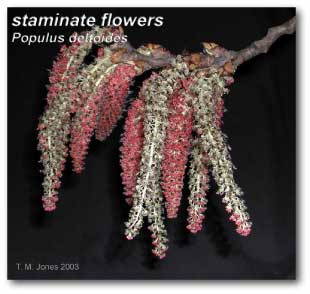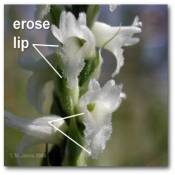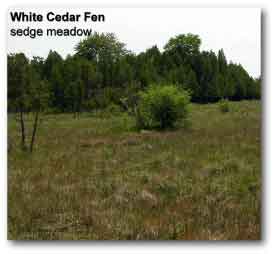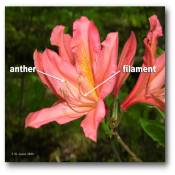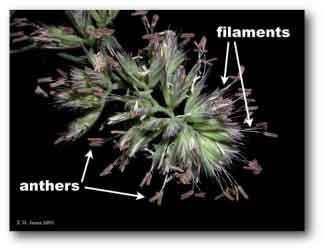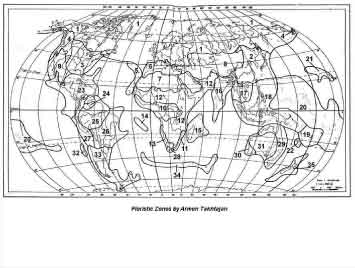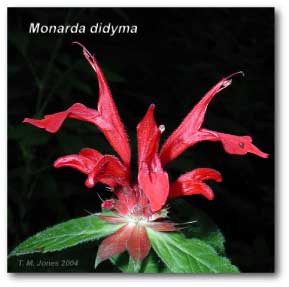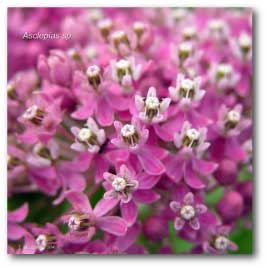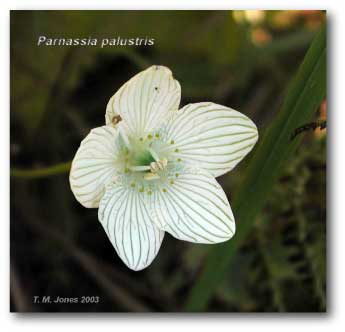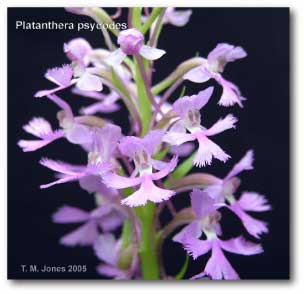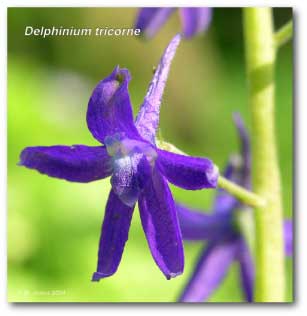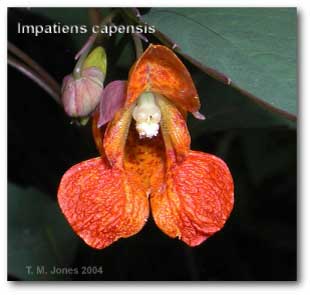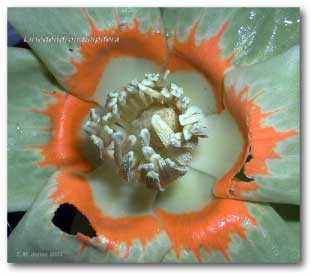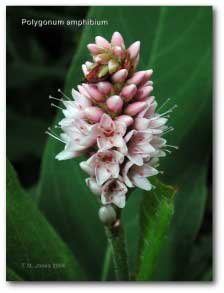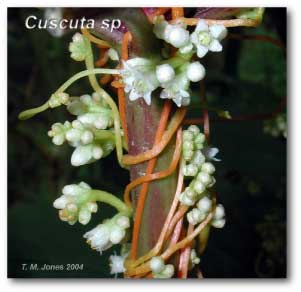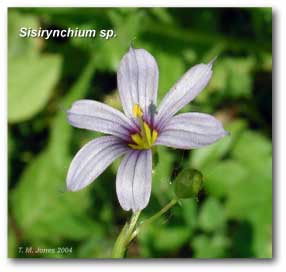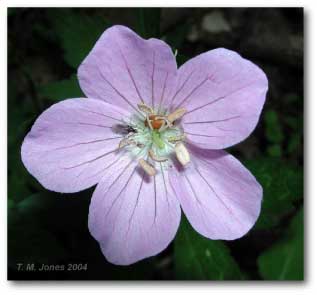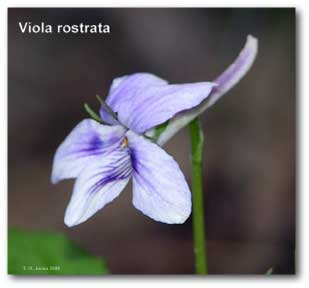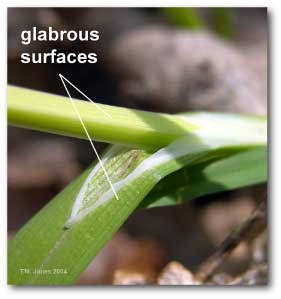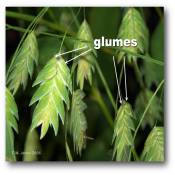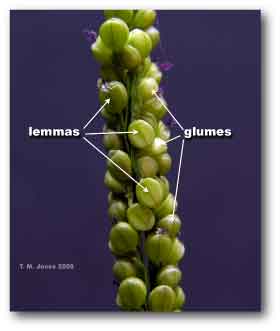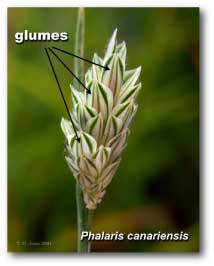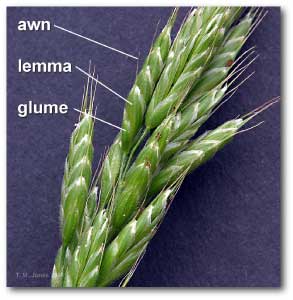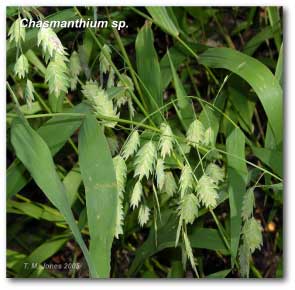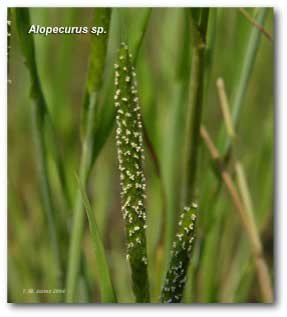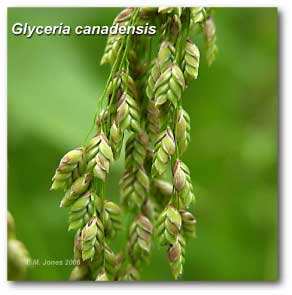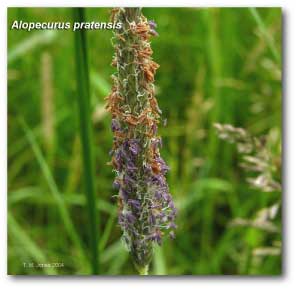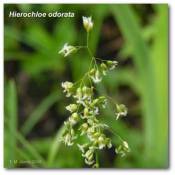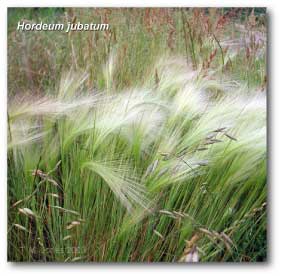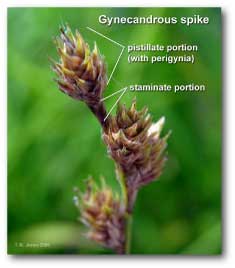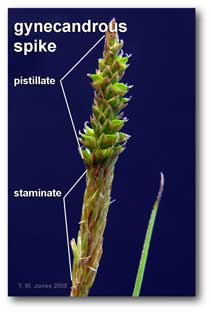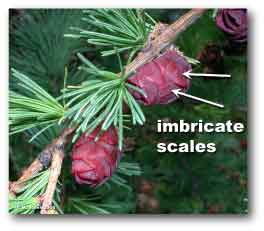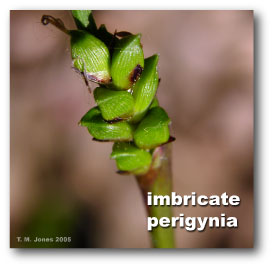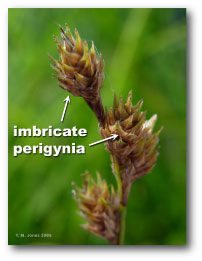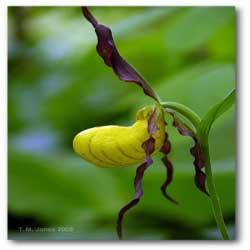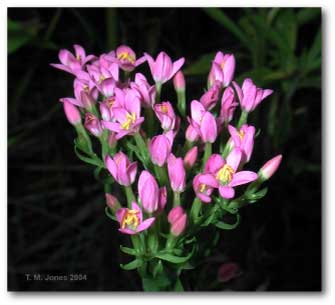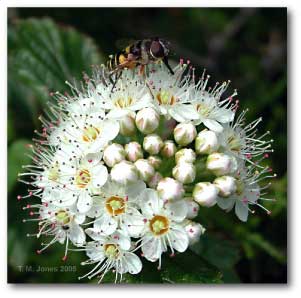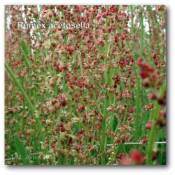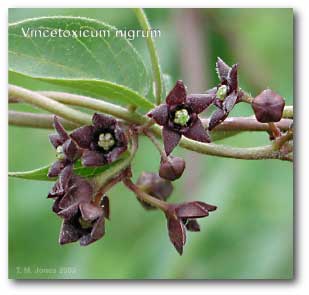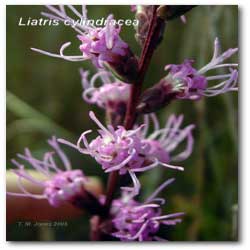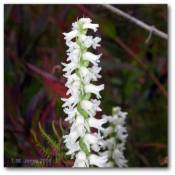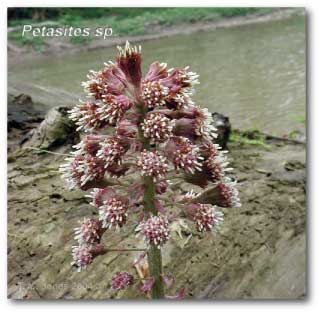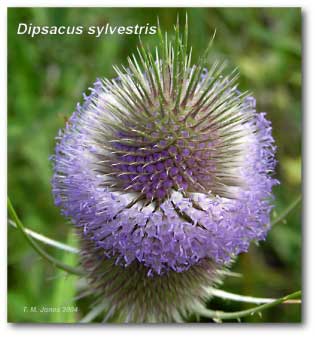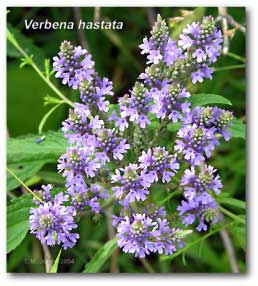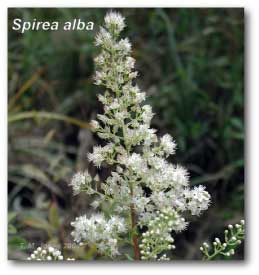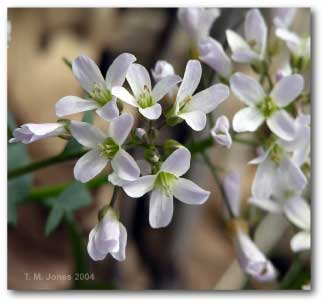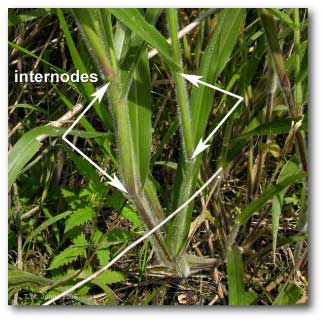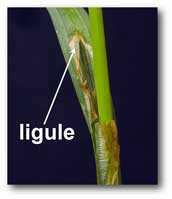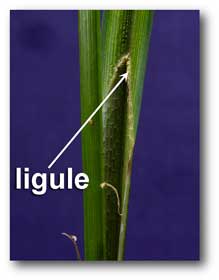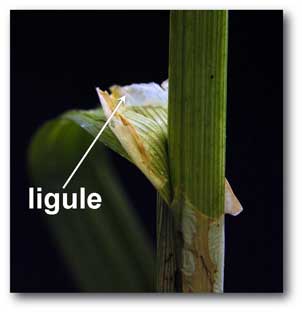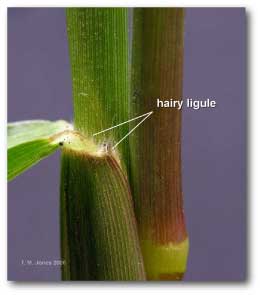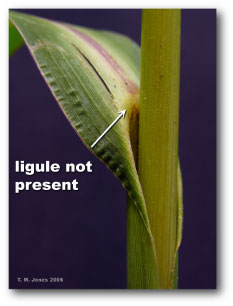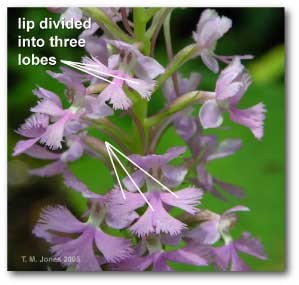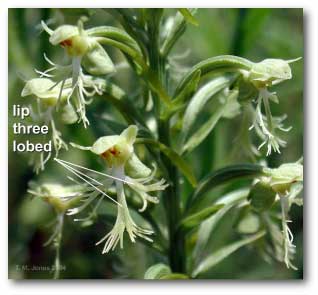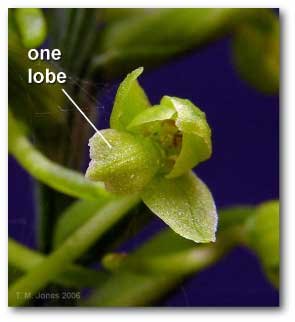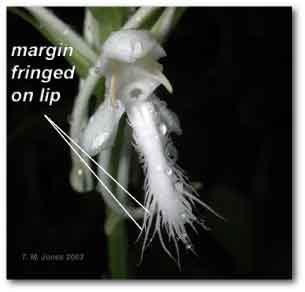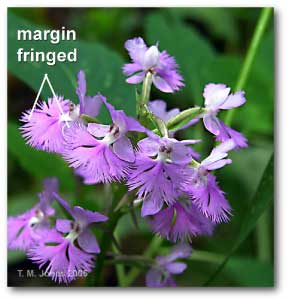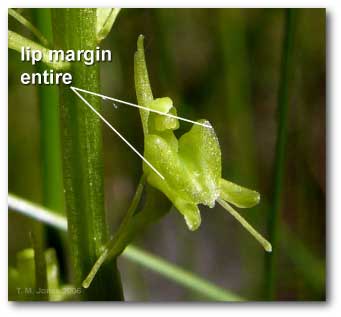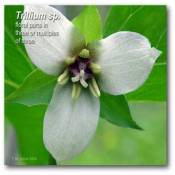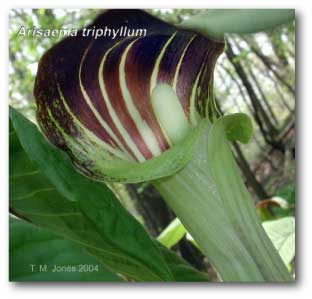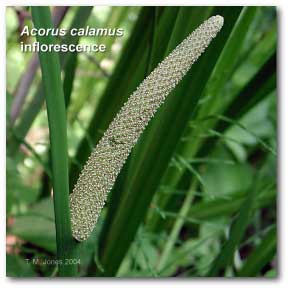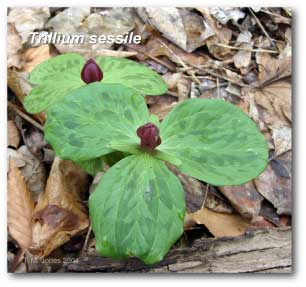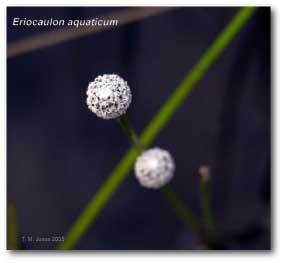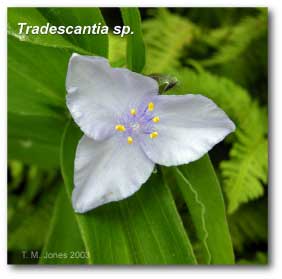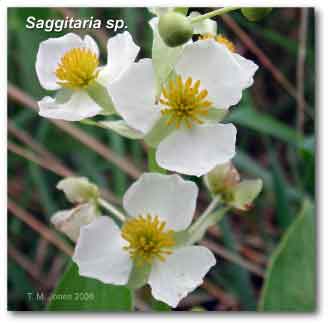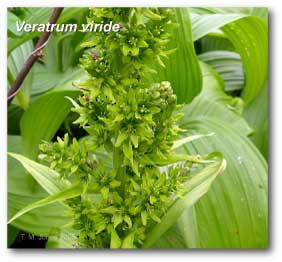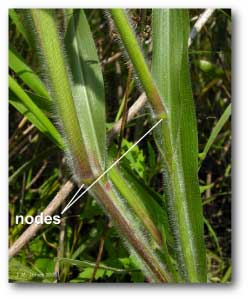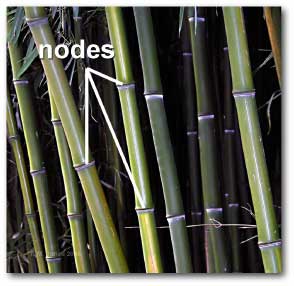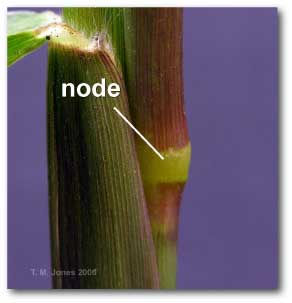abaxial :
Surface furthest from the axis; usually the lower side of a structure, such as a leaf or a bract.
achene :
A dry, indehiscent one-seeded fruit in which the seed is readily separated from the fruit wall. In Carex, located inside a perigynium. The term " achene" is sometimes restricted to fruits developed from a superior ovary, as in buckwheat ( Fagopyrum and other members of the Polygonaceae), achene-like fruits developed from inferior ovaries being called cypselas. See also caryopsis.
acuminate :
A narrowly pointed tip with somewhat concave side; see acute.
acute :
A pointed tip with straight or slightly convex sides; see acuminate.
adaxial :
Surface furthest from the axis; usually the lower side of a structure, such as a leaf or a bract.
Used to describe two different structures that are fused together; compare with connate.
alate :
Wing-like extensions; margins extended out into flat surfaces resembling "wings".
alvar :
A limestone plain overlain with no soil or thin layers of alkaline soils.
alvars :
Plural for alvar
analogous :
In biology, structures having the same function but different evolutionary origins. The fins of fish and whales are analogous, not homologous. The pseudopetioles found in some grasses are analogous, not homogolous, with the petioles of ordinary leaves.
androgynecandrous :
A spike with staminate flowers at the top and bottom and pistillate flowers in between; note how "andr", meaning male, is on either side of "gyn", meaning female.
androgynous :
In botany, a spike with staminate flowers at the top and pistillate flowers in the bottom portion
angiosperms :
Plants that produce flowers. The flowers of some plants have conspicuous colorful petals. In the Poaceae and Cyperaceae (and several other flowering plant families), the flowers are inconspicuous. Angiosperms produce seeds that are enclosed in an ovary.
annual :
A plant that completes its entire life cycle within one growing season or year. See also biennial, perennial, and monocarpic.
anther :
The pollen-containing portion of a stamen. Anthers are attached to filaments, the two parts together making a stamen.
anthesis :
Period when anthers split open, shedding pollen; usually also includes period when style branches are receptive as is evident from their glistening appearance.
aperture :
An opening into a structure, usually small.
apically :
Apical. At the top (or apex); opposite is basal.
appressed :
Laying upon the surface of a structure.
Asteraceae :
The family of flowering plants that includes sunflowers, daisies, dahlias, and dandelions. Its members have several small flowers or florets that have an inferior ovary and are sessile on a common receptacle.
awn :
A bristlelike stucture formed by one or more veins that extend beyond the edge or from the back or base of a structure, usually a structure that is part of the dispersal unit. In grasses, awns are frequently associated with lemmas and, less frequently, with glumes and paleas.
awned :
Possessing an awn.
return to top
B
basal :
At the base or bottom; compare with apical.
basally :
At the base or bottom; opposite is apically.
beak :
An abruptly narrowed extension of a structure. In
Carex, the abruptly narrowed tip of a
perigynium or
achene; not present in
all
perigynia or all achenes, sometimes poorly defined.
beak teeth :
Projections at the tip of the beak of the perigynium, typically paired, may be curved or straight. Some perigynia have beaks that do not have teeth.
biconvex :
An flattish object that is thickest in the center and has curved sides; like a magnifying glass; see planoconvex.
bisexual :
Possessing both
pistillate and
staminate flowers. Within Carex, they may be borne seperately on spikes or mixed.
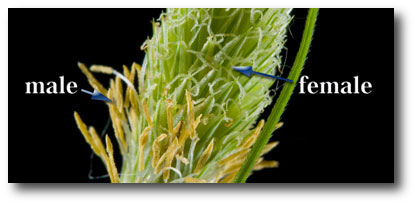
blade :
Distal portion of a leaf. In most
dicotyledonous plants, the
basal portion of a leaf is a narrow, stem-like structure, called a
petiole. In
grasses, sedges,and some other monocots, the
basal portion embraces the stem and is called a
sheath. Petioles and sheaths are not
homologous. See also
pseudopetiole.

bog :
A type of wetland that is fed by precipitation; typically is acidic and nutrient poor; supporting plants adapted to low nitrogen environments. Because of the nutrient poor environment, carnivorous plants are frequently present.
bract :
A modified leaf-like structure that subtends a flower or branch within an inflorescence. The bracts that subtend perigynia ( pistillate flowers) or stamens ( staminate flowers) in Carex are usually called scales or, in other counties, glumes. The glumes, lemmas, and paleas of grasses are also bracts.
return to top
C
calcareous :
Calcium containing soils, such as those derived from limestone; calcareous soils are alkaline.
callus :
A hard, solid portion of tissue. Calluses often develop on diaspores. Because calluses are dense, diaspores tend to land callus-first. This usually results in the seed landing with its embryonic root pointing downwards. This gives the seedling a slight advantage in becoming established over those that land with their embryonic roots pointing upwards. In grasses, a callus is often developed at the base of a lemma or spikelet. They are frequently sharply pointed.
capitate :
Shaped like a head; spherical.
carnivorous :
In botany, plants that actively or passively trap and consume animals for food; chiefly arthropods.
caryopses :
Plural of caryopsis.
caryopsis :
The fruit formed by grasses. It is a one-seeded indehiscent fruit in which the embryo is attached to a scutellum. In addition, the seed wall is usually fused to the ovary wall. See also achene and cypsela.
cespitose :
Perennial species that form dense clumps of stems or culms. The term refers to the appearance of the plant above ground level. Cespitose plants may have rhizomes, but the rhizomes are short and do not connect the clumps. See also rhizomatous, soboliferous, pluricespitose.
Caespitose is an alternative spelling of cespitose.
clasping :
Wrapped around or surrounding; often used to describe the base of sessile blades or the blades of some grasses and sedges.
column :
In Orchidaceae, also known as the gynostemium, a fusion of the all reproductive parts resulting in one pillar of tissue supporting both pistillate and staminate flowers.
Compositae :
The family of flowering plants that have inflorescences composed of several small flowers that are sessile on a common receptacle. The family has two scientific names, Asteraceae or Compositae. Examples of composites are dandelions, sunflowers, and daisies.
connate :
Describes similar structures that are fused together, such as the edges of a leaf sheath or the petals of some flowers such as those of tomatoes. See adnate.
constrictions :
In botany, a narrowing in a structure; appears crinkled.
coriaceous :
Tough, leathery. See indurate.
corolla :
One of the whorls of bracts that surround the stamens in most flowers. It is usually colorful. Corolla refers to all the petals in a flower. Some flowers, such as those of buttercups and roses, have a corolla composed of several separate petals. In other other flowers, such as those of tomatoes and lilacs, the corolla is composed of connate petals. Some flowering plants, including members of the grass and sedge families ( Poaceae and Cyperaceae, respectively), do not have petals.
culm :
Stems that bear one or more inflorescences and have leaves with a basal sheath. Used mostly (in North America) in discussions of the grass and sedge families ( Poaceae and Cyperaceae, respectively). See innovation.
Cyperaceae :
A herbaceous monocot plant family comprised of approximately 100 genera and 5000 species worldwide (Goetghebeur 1998). Culm usually trigonous in cross section with three-ranked leaves with closed sheaths; with inconspicuous flowers that are subtended by a bract generally known as a scale; perianth if present, is composed of bristles or a scale that wholly or partly surrounds the ovary.
cypsela :
An indehiscent, one-seeded fruit that is developed from an inferior ovary with one locule. Cypselas are characteristic of the Asteraceae or composite family. See also achene, caryopsis.
return to top
D
deciduous :
Said of something that sheds some its parts. For example, deciduous trees have leaves that fall off. In Carex, several species have deciduous styles, they break off from the achene after pollination.
dehiscent :
Splitting open at maturity. Many fruits are dehiscent, for example pea pods and iris capsules.
diaspore :
The dispersal unit of a plant. This is often the fruit, but may be the fruit with various accessory structures. In grasses, the dispersal unit is often a floret or spikelet rather than just the caryopsis. In Carex, it is the perigynium with the achene inside.
dicotyledonous (adj.)
A plant that has two cotyledons or embryonic leaves in the seed.
dioecious :
Species that have separate staminate and pistillate plants; all flowers on a plant of the same sex; see monoecious and synoecious.
disarticulate :
To disarticulate (verb):
To break up or fall off naturally. In Carex, perygnia diarticulate from the floral axis at maturity. In grasses, disarticulation may occur in below an inflorescence, below a pair of spikelets, below individual spikelets, or below the florets.
disarticulates :
See disarticulation
disarticulation :
Disarticulation (noun):
Breaking off naturally, as when perigynia fall off their floral axis.
distal :
Further from the base or roots than some other structure for example: in Carex, the inflorescence is distal to the leaves; see proximal.
return to top
E
erose :
An irregular margin; of an edge that appears chewed or gnawed.
extirpated :
Removed from a given area, generally used when the removal is the result of human action, either direct or indirect; used to describe populations of species known to have been present in an area within historical times.
return to top
F
facultative :
Able to, under the right circumstances; used to describe plants that can grow in both wet and dry environments. Compare with obligate.
fens :
Wetlands with a continuous source of groundwater that has relatively high concentrations of magnesium and calcium; because of the magnesium and calcium salts, fens are alkaline to neutral. Compare with bogs.
filament :
The lower, often threadlike, part of a stamen. Anthers are attached to the distal end of filaments. Together, a filament and anther form a stamen. Wind-pollinated plants have stamens with long, flexible filaments and versatile anthers. Animal-pollinated plants usually have short, stiff flaments.
floret :
A small flower. In grasses the unit formed by a lemma, palea, and the parts between these two structures.
Floristic Province :
A geographic area, usually rather large, that contains a more or less uniform assemblage of plants; the boundaries between floristic provinces are not precise; see map within key for Takhtajan's floristic provinces of North America.
flower :
In most flowering plants, a flower consists of a calyx, corolla, stamens and pistils and is the sexual reproductive structure. The corolla is often colorful and showy. Many species have flowers that lack a corolla, or stamens, or pistils, or some combination of these structures. In Carex, the perigynium is probably homologous with a calyx; in grasses, the lodicules are generally considered to be homologous with the calyx.
flowering plants :
Plants in which the seeds are produced inside an ovary and fertilization involves two sperm nuclei, one to fertilize the egg, the second to fertilize the polar nuclei. In most flowering plants, the ovary is surrounded by stamens, petals, and sepals.
fusiform :
Spindle-shaped; tapering on both ends.
return to top
G
glabrous :
Without hairs, usually interpreted as also meaning smooth.
glume :
Singular of glumes
glumes :
The lowest pair of bracts in a typical grass spikelet. They are often described as empty because they do not have any structures in their axils. In some species, one or both glumes may be absent or highly reduced. See also pseudospikelets
>grasses :
A family of herbaceous flowering plants in which the leaves are two-ranked, the flowering stems (culms) are round in cross section, and the flowers are inconspicuous, being concealed between two bracts, the lemma and palea, and the fruit is a caryopsis. Grasses constitute the fourth largest plant family in terms of number of species.
gynecandrous :
Spikes with the pistillate flowers above the staminate flowers; see also androgynous and androgynecandrous.
return to top
H
halophyte :
halophyte (noun),
A plant that grows well in, or requires, saline soil. They are often found along roads and sidewalks in cities or communities where salt is used for snow removal.
halophytic :
The adjectival form of halophyte.
return to top
I
imbricate :
Overlapping; like the scales on a fish or the tiles on a roof.
indehiscent :
Not splitting open. Fruits such as achenes and nuts are indehiscent. See dehiscent.
indumentum :
Hairs that cover a surface.
inferior :
Lower. In botany, used to describe flowers in which the calyx and corolla are attached to the receptacle below the ovary. Honeysuckle flowers have an inferior ovary. See epigynous. Compare with superior.
inflorescence :
A cluster of flowers within a plant that may contain one to many flowers. There may be several inflorescences on a single plant. In the grass and sedge families ( Poaceae and Cyperaceae, respectively) the apparent inflorescences are, strictly speaking, synflorescences. The primary inflorescence in the grass family is the spikelet; in the sedge family it is the spike. In most references however, the term inflorescence is used for the synflorescence.
insolated :
Exposed to sunlight .
internode :
A portion of stem between two nodes.
return to top
L
lateral :
On the side.
lateral spike :
Spike on the side of the axis in an inflorescence of many spikes.
lemma :
One of two bracts that enclose the reproductive structures (lodicules, stamens, and pistil) of grasses, the other being the palea. The lemma is the lower, and usually the larger, of the two bracts. It usually has an odd number of veins. Lemmas may also be sterile and lack a palea and lodicules.
life cycle :
The period from one stage in one generation to the same stage in the next generation.
ligule :
In the grass and sedge families ( Poaceae and Cyperaceae, respectively), tissue or hairs at the junction of the sheath and the blade. Almost all members of both families have a ligule on the adaxial or inner side of the leaf; some bamboos also have ligules on the abaxial side of the leaf. In sedges, the ligule is usually hyaline to membranous.
lip :
A modified petal in the Orchidaceae; frequently a landing area for a pollinator. Also called the labellum.
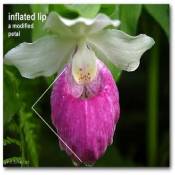 .
.
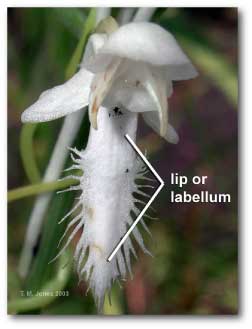
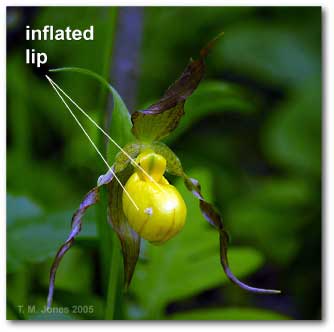
lobe :
A somwhat rounded projection of a structure; in Platanthera, it refers to the primary subdivisions of the lip.
locule :
Chamber; used to refer to the separate sections within an ovary. Oranges and lemons have many locules; melons and cucumbers have one locule. Achenes have one locule.
lodicule :
Very small structures in grasses that are located outside the stamens. The lodicules are homologous with the calyx and/or corolla of ordinary flowers. Grasses have two, three, or no lodicules. They are not used in identification but are significant in classification. At anthesis, they swell and help to spread open the lemma and palea.
return to top
M
margin :
The edges of a structure.
monoecious :
Species in which individual flowers are unisexual but individual plants have both staminate and pistillate flowers; the usual condition in Carex; see dioecious and synoecious.
monocarpic :
Flowering once and then dying. Annual and biennial plants are monocarpic, as are century plants and many bamboos.
monocot :
Plants whose seeds and seedlings have only one seedling leaf. Monocots also usually have a corolla and calyx that consists of 3 parts or a multiple of 3, scattered vascular bundles in their stems, and often have leaves with parallel venation. Grasses ( Poaceae) and members of the sedge family ( Cyperaceae) are monocots, as are lilies and orchids.
multispicate :
Composed of more than one spike.
return to top
N
node :
The place on a stem where a leaf is attached or, in an inflorescence, the place where a branch is attached to the central axis or another branch.
return to top
O
obligate :
Plants that cannot grow in an area unless a particular condition is met; obligate wetland species cannot grow in dry habitats; obligate xeric species cannot grow in wetland habitats. Many species of Carex are obligate wetland species, they can only grow in wetlands. See facultative.
ovary :
In botany, the structure that encloses the seeds of flowering plants. Ovaries mature into fruits.
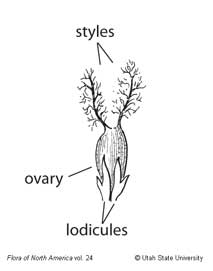
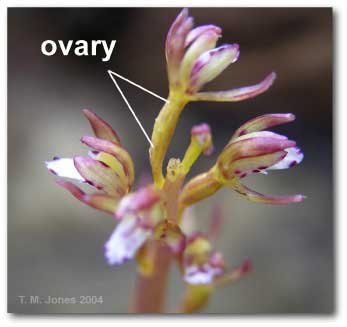
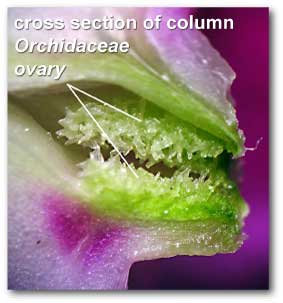
return to top
P
palea :
One of two
bracts that enclose the reproductive parts of a grass, the other being the
lemma. The
palea is the upper of the two
bracts and usually has two major veins. Additional veins may be present also.
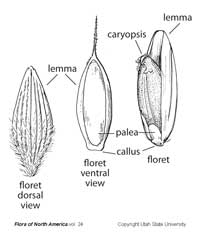
panicle :
An inflorescence containing branches that bear higher orders of branching.
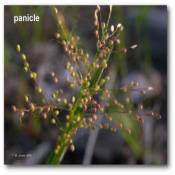
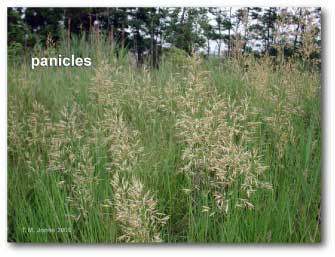
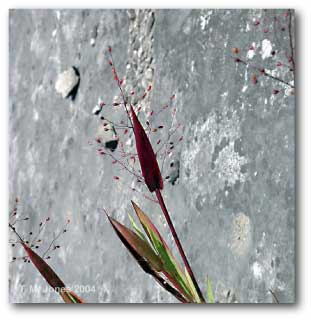
paniculate :
Panicle-like; an
inflorescence with primary branches that bear multiple flowers. Higher order branching in Carex may not be obvious, dissection is usually required.
peduncle :
The portion of stem from the uppermost leaf
node to the base of an
inflorescence.
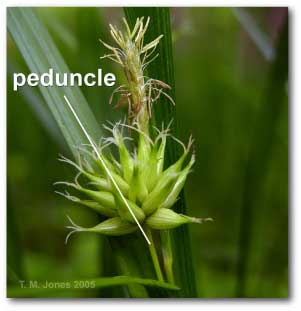
pendant :
Hanging down.
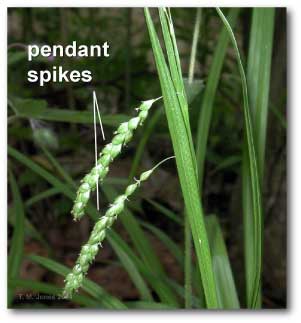
perigynia :
A sac-like structure that envelops the
achene in some members of the Cyperaceae. The plural is
perigynia .
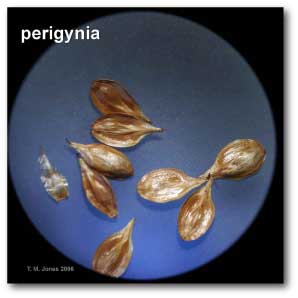
perigynium :
A sac-like structure that envelops the
achene.
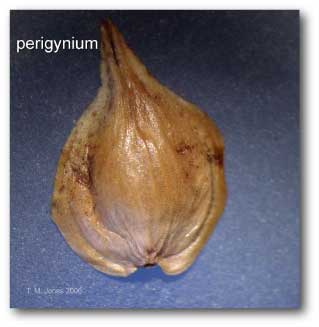
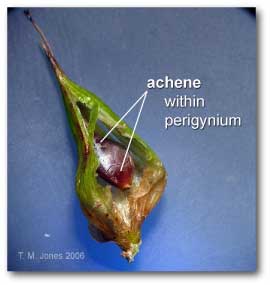
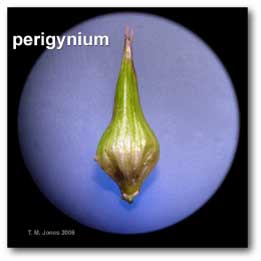
perigynium -singular
perigynia - plural
perennial :
Plants that live for longer than one year and do not die after producing flowers and seeds.
persistent :
In botany, a structure that remains attached to a plant; in Carex, describes styles that do not wither and fall off the
achene.
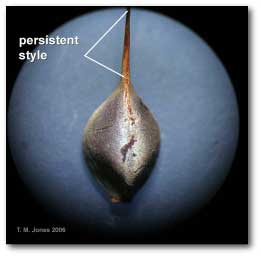
petal :
One of the
bracts that surrounds the stamens in an ordinary
flower. Petals are often colorful in visible light and often prominently marked in other invisible wavelengths; chiefly for the many pollinating insects that can see in ultaviolet light.
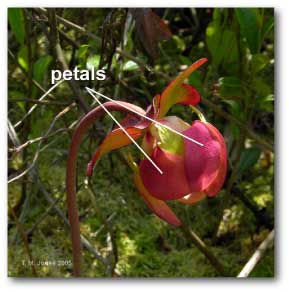
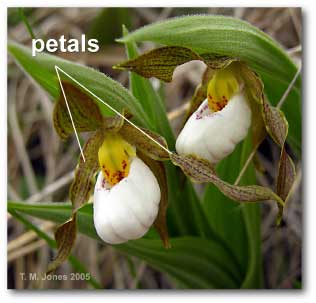
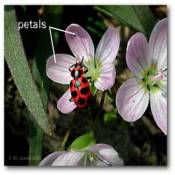
petiole :
The stalk of an ordinary
dicotyledonous leaf. It usually does not surround a stem, as does the
sheath of leaves in the grass and sedge families (
Poaceae and
Cyperaceae, respectively).
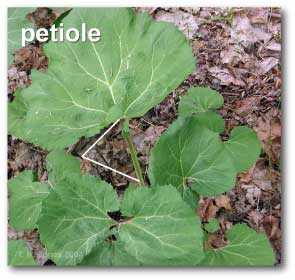
pistillate :
Pertaining to female flowers, having a pistil and, in
Carex, surrounded by a
perigynium.
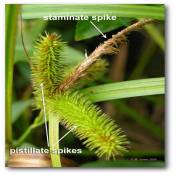
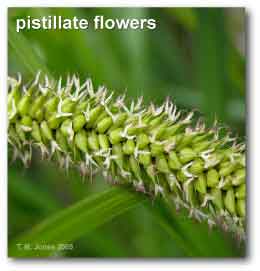
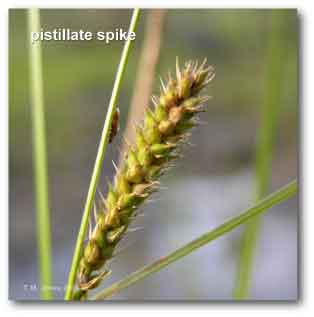
pistillate scale :
Small
bract that subtends a
perigynium.
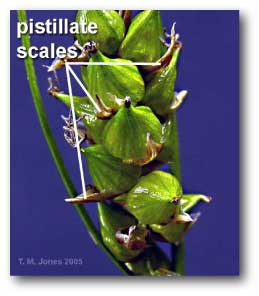
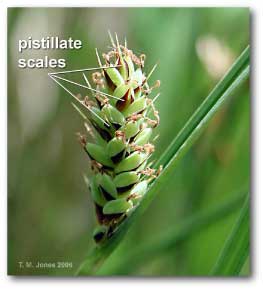

planoconvex :
A structure that, in cross section, is flat on one side and
rounded outwards (convex) on the other side; see
biconvex
pollinia :
A coherent mass of pollen grains.
Pollinium is singular.
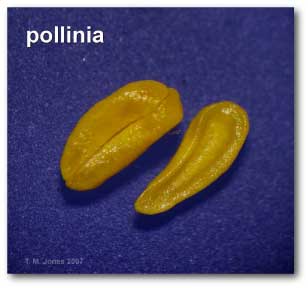
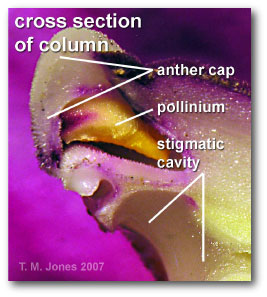
proximal :
Closest to ground or roots. The opposite is
distal.
proximal internode : :
In Carex, the
internode between point of attachment of the lowest and second lowest spike of the
inflorescence.
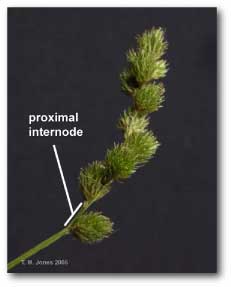
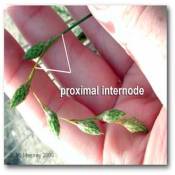
pseudopetiole :
A narrow portion at the base of the
blade of some
grasses that resembles a petiole, as in some bamboos and panicoid grasses.
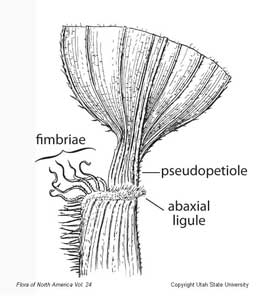
pubescent :
In North America, often used to mean hairy; having soft, short
appressed hairs.
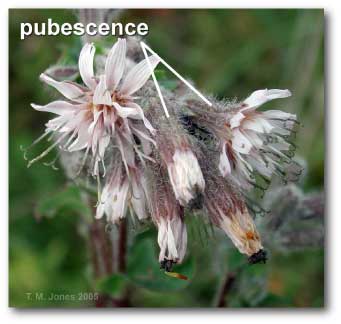
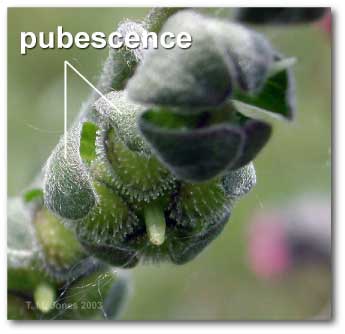
return to top
R
racemose :
Like a raceme; an
inflorescence with primary branches attached along a central axis and no secondary branches.
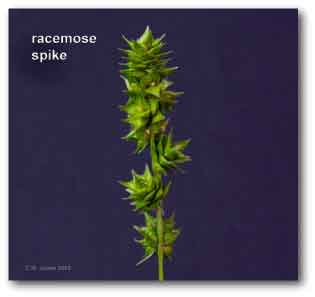
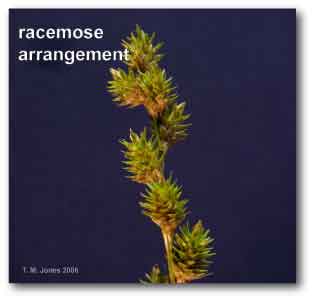
rachilla :
The primary axis of the spikelet in grasses.
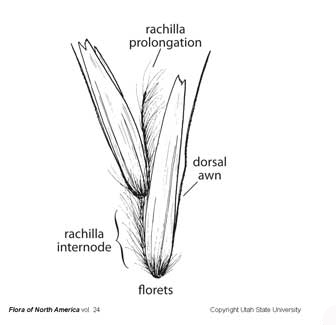
rame :
A term used for branches of the
Andropogoneae in which the spikelets are in sessile-pedicellate pairs, with
disarticulation being in the
rame, beneath the sessile spikelet. The pedicellate spikelet may be absent, vestigial, sterile, or
staminate.
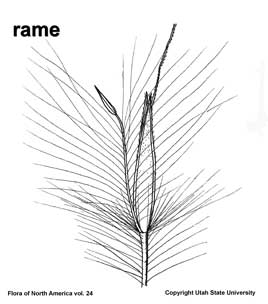
receptacle :
The tip of a pedicel to which the parts of a
flower are attached. Members of the
Asteraceae have enlarged pedicels, allowing for development of multiple flowers on a single receptacle.
reflexed :
Bent backwards or, when referring to an
inflorescence branch, hanging downwards
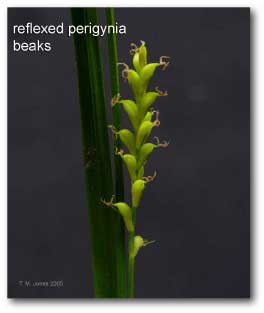
resupinate :
Describes orchid flowers in development that turn 180 degrees prior to anthesis.
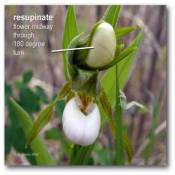
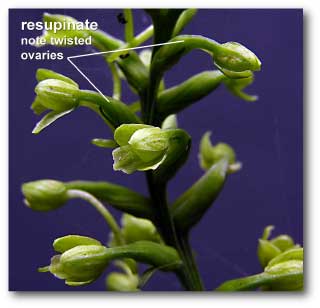
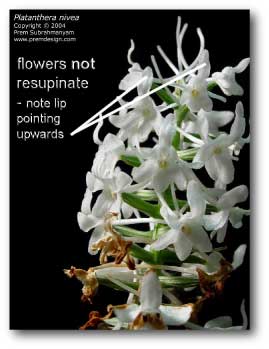
rhizomatous :
Having rhizomes. Sometimes used to refer to plants that grow with one or a few stems together, the clusters being connected by rhizomes.
rhizome :
An underground stem that enables a plant to extend its range; differs from a root in having reduced leaves and forming roots at the nodes.
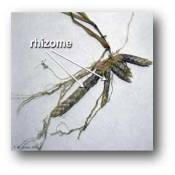
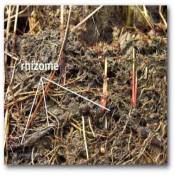
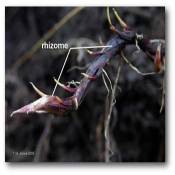
riparian :
Land area adjacent to a moving body of fresh water; the bank of a river or stream.
rostellum :
A small beak-like projection .
rounded :
A tip that is curved in outline, like a thumbnail.
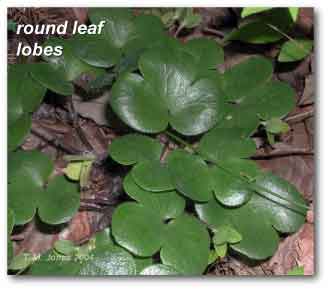
return to top
S
saccate :
Appearing like a sack; inflated on one end.
scutellum :
In
grasses, the shield-shaped cotyledon to which the embryo is attached. It helps transfer nutrients from the endosperm to the embryo.
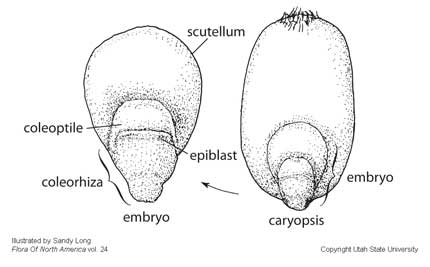
sepal :
One of the outer components of the calyx, in orchids usually comprised of both two laterals and a dorsal components.
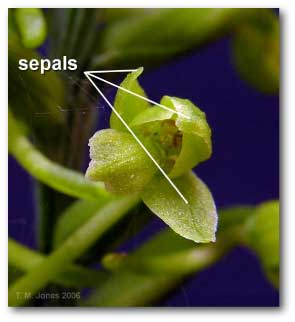
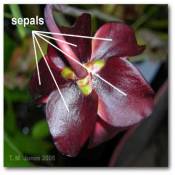
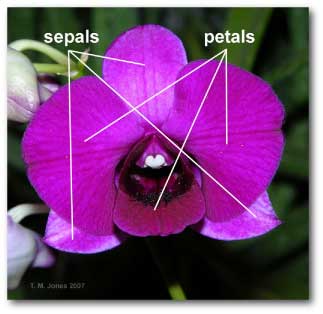
second internode :
In
Carex, the
internode between the attachment of the second and third spike counting from the bottom of the
inflorescence.
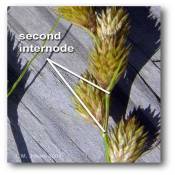
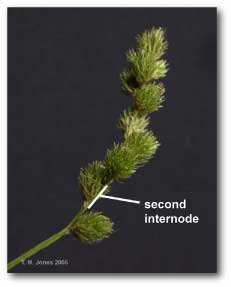
setaceous :
Bristle-like.
sheath :
The
basal part of a leaf that wraps around the
culm in
grasses and sedges. In grass leaves, the
sheath is usually open - its margins may overlap but are not fused together. In
Carex, the sheaths are closed - the margins are fused together for most of their length.
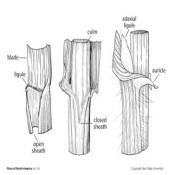
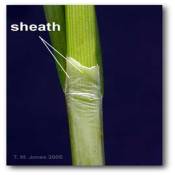
spicate :
Spike like in appearance.
spike :
Usually an elongate, unbranched inflorescence consisting of sessile flowers that are attached directly to the rachis and not to a branch.
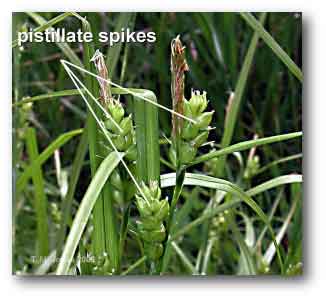

spikelet :
A basic unit of the inflorescence in grasses, usually comprising two glumes and one or more florets; in sedges, refers to a pistillate or staminate scale and the subtended flower.
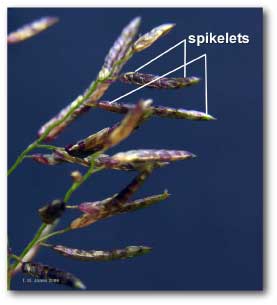
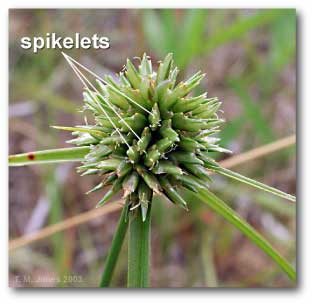
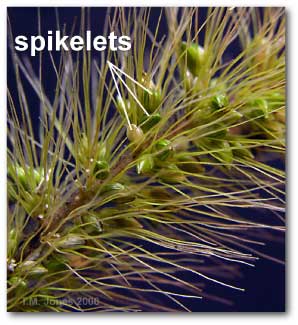
spur :
In Platanthera, a hollow projection that arises from the petals and sepals that forms a collection structure for the nectary.
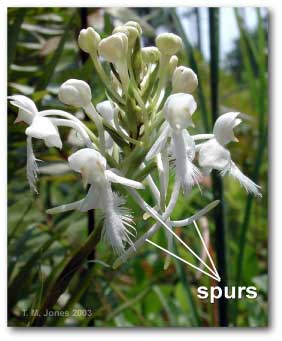
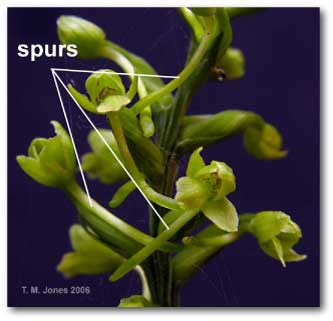
staminate :
Flowers having stamens or plants possessing flowers with stamens only; male flowers.
Staminate flowers may be difficult to find if they are mixed in with
pistillate flowers or have shed their anthers.
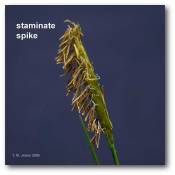
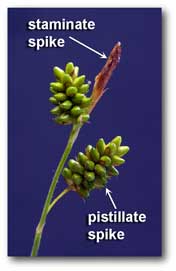
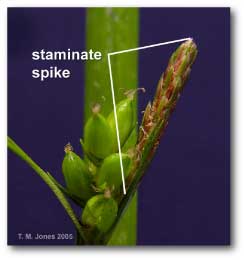
staminate scale :
A relatively small
bract that subtends each
staminate
flower.
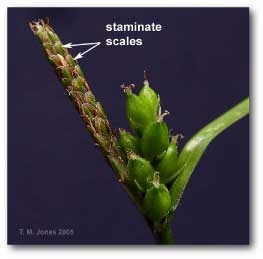
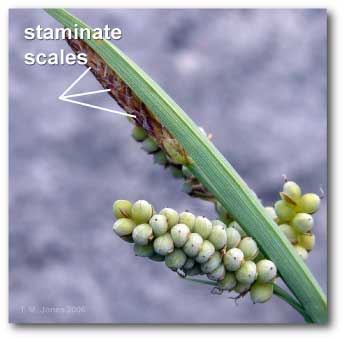
stigma :
The part of the
style
that is receptive to pollen, usually at the end or tip of the
style. In Carex, usually two to three in number.
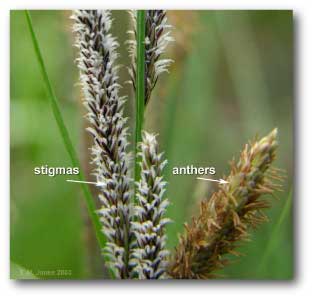
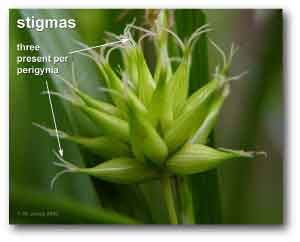
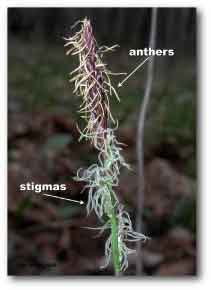
style :
The sometimes elongated portion between the
ovary and the stigma; connects the two structures.
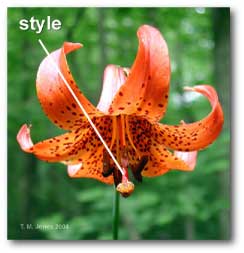
succulent :
Fleshy, appearing thick and juicy.
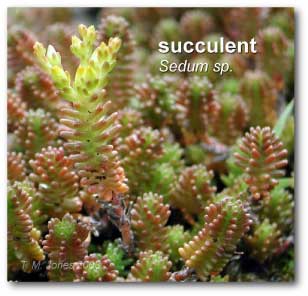
synoecious :
Species in which individual flowers are both
staminate and
pistillate; the condition in most
flowering plants, not known in Carex; see also
dioecious and monoecious.
return to top
T
terminal spike :
The top spike on a
culm; the apical spike on a culm
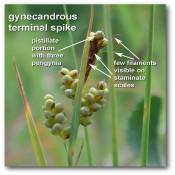
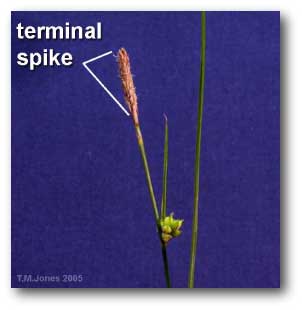
trigonous :
Triangular in cross section; tri means three, gonum means angle
truncate :
A tip that is squared off, or cut straight across.
tubercle :
A small protuberance or projection in a structure.
tussocks :
Clumps formed by plants.
return to top
U
unisexual :
Of one sex; said of flowers that are either
staminate or
pistillate but not both; this is the condition of all flowers in Carex.
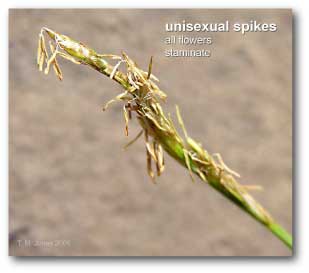
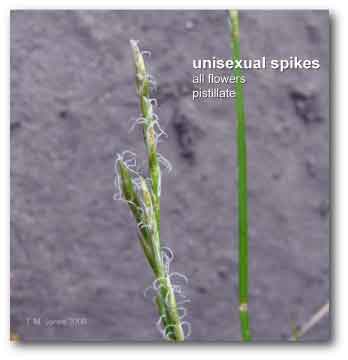
unispicate :
Composed of a single spike; see
multispicate
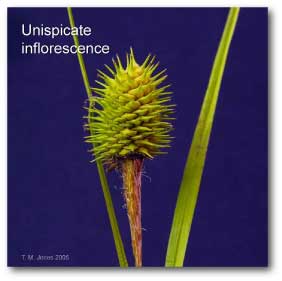
upland :
Area that is higher than surrounding area; usually not a wetland although there may be small wetland areas within an upland area.
utricle :
A dry, thin-walled fruit surrounding a
seed as in beet and doc;
homologous with an
achene. Considered to be a synonym of
perigynium.
return to top
V
vegetative :
A leaf not associated with a fertile
culm. Plant parts that are not involved in sexual reproduction such as leaves, roots, and stems.
vein :
In plants, a
vascular
bundle. Refered to as veins because they are responsible for the transport of fluids. Also referred to as "nerves".
return to top
P
palea :
One of two bracts that enclose the reproductive parts of a grass, the other being the lemma. The palea is the upper of the two bracts and usually has two major veins. Additional veins may be present also.
panicle :
An inflorescence containing branches that bear higher orders of branching.



paniculate :
Panicle-like; an
inflorescence with primary branches that bear multiple flowers. Higher order branching in Carex may not be obvious, dissection is usually required.
peduncle :
The portion of stem from the uppermost leaf
node to the base of an
inflorescence.

pendant :
Hanging down.

perigynia :
A sac-like structure that envelops the
achene in some members of the Cyperaceae. The plural is
perigynia .

perigynium :
A sac-like structure that envelops the
achene.



perigynium -singular
perigynia - plural
perennial :
Plants that live for longer than one year and do not die after producing flowers and seeds.
persistent :
In botany, a structure that remains attached to a plant; in Carex, describes styles that do not wither and fall off the
achene.

petal :
One of the
bracts that surrounds the stamens in an ordinary
flower. Petals are often colorful in visible light and often prominently marked in other invisible wavelengths; chiefly for the many pollinating insects that can see in ultaviolet light.



petiole :
The stalk of an ordinary
dicotyledonous leaf. It usually does not surround a stem, as does the
sheath of leaves in the grass and sedge families (
Poaceae and
Cyperaceae, respectively).

pistillate :
Pertaining to female flowers, having a pistil and, in
Carex, surrounded by a
perigynium.



pistillate scale :
Small
bract that subtends a
perigynium.



planoconvex :
A structure that, in cross section, is flat on one side and
rounded outwards (convex) on the other side; see
biconvex
pollinia :
A coherent mass of pollen grains.
Pollinium is singular.


proximal :
Closest to ground or roots. The opposite is
distal.
proximal internode : :
In Carex, the
internode between point of attachment of the lowest and second lowest spike of the
inflorescence.


pseudopetiole :
A narrow portion at the base of the
blade of some
grasses that resembles a petiole, as in some bamboos and panicoid grasses.

pubescent :
In North America, often used to mean hairy; having soft, short
appressed hairs.


return to top
R
racemose :
Like a raceme; an
inflorescence with primary branches attached along a central axis and no secondary branches.


rachilla :
The primary axis of the spikelet in grasses.

rame :
A term used for branches of the
Andropogoneae in which the spikelets are in sessile-pedicellate pairs, with
disarticulation being in the
rame, beneath the sessile spikelet. The pedicellate spikelet may be absent, vestigial, sterile, or
staminate.

receptacle :
The tip of a pedicel to which the parts of a
flower are attached. Members of the
Asteraceae have enlarged pedicels, allowing for development of multiple flowers on a single receptacle.
reflexed :
Bent backwards or, when referring to an
inflorescence branch, hanging downwards

resupinate :
Describes orchid flowers in development that turn 180 degrees prior to anthesis.



rhizomatous :
Having rhizomes. Sometimes used to refer to plants that grow with one or a few stems together, the clusters being connected by rhizomes.
rhizome :
An underground stem that enables a plant to extend its range; differs from a root in having reduced leaves and forming roots at the nodes.



riparian :
Land area adjacent to a moving body of fresh water; the bank of a river or stream.
rostellum :
A small beak-like projection .
rounded :
A tip that is curved in outline, like a thumbnail.

return to top
S
saccate :
Appearing like a sack; inflated on one end.
scutellum :
In
grasses, the shield-shaped cotyledon to which the embryo is attached. It helps transfer nutrients from the endosperm to the embryo.

sepal :
One of the outer components of the calyx, in orchids usually comprised of both two laterals and a dorsal components.



second internode :
In
Carex, the
internode between the attachment of the second and third spike counting from the bottom of the
inflorescence.


setaceous :
Bristle-like.
sheath :
The
basal part of a leaf that wraps around the
culm in
grasses and sedges. In grass leaves, the
sheath is usually open - its margins may overlap but are not fused together. In
Carex, the sheaths are closed - the margins are fused together for most of their length.


spicate :
Spike like in appearance.
spike :
Usually an elongate, unbranched inflorescence consisting of sessile flowers that are attached directly to the rachis and not to a branch.


spikelet :
A basic unit of the inflorescence in grasses, usually comprising two glumes and one or more florets; in sedges, refers to a pistillate or staminate scale and the subtended flower.



spur :
In Platanthera, a hollow projection that arises from the petals and sepals that forms a collection structure for the nectary.


staminate :
Flowers having stamens or plants possessing flowers with stamens only; male flowers.
Staminate flowers may be difficult to find if they are mixed in with
pistillate flowers or have shed their anthers.



staminate scale :
A relatively small
bract that subtends each
staminate
flower.


stigma :
The part of the
style
that is receptive to pollen, usually at the end or tip of the
style. In Carex, usually two to three in number.



style :
The sometimes elongated portion between the
ovary and the stigma; connects the two structures.

succulent :
Fleshy, appearing thick and juicy.

synoecious :
Species in which individual flowers are both
staminate and
pistillate; the condition in most
flowering plants, not known in Carex; see also
dioecious and monoecious.
return to top
T
terminal spike :
The top spike on a
culm; the apical spike on a culm


trigonous :
Triangular in cross section; tri means three, gonum means angle
truncate :
A tip that is squared off, or cut straight across.
tubercle :
A small protuberance or projection in a structure.
tussocks :
Clumps formed by plants.
return to top
U
unisexual :
Of one sex; said of flowers that are either
staminate or
pistillate but not both; this is the condition of all flowers in Carex.


unispicate :
Composed of a single spike; see
multispicate

upland :
Area that is higher than surrounding area; usually not a wetland although there may be small wetland areas within an upland area.
utricle :
A dry, thin-walled fruit surrounding a
seed as in beet and doc;
homologous with an
achene. Considered to be a synonym of
perigynium.
return to top
V
vegetative :
A leaf not associated with a fertile
culm. Plant parts that are not involved in sexual reproduction such as leaves, roots, and stems.
vein :
In plants, a
vascular
bundle. Refered to as veins because they are responsible for the transport of fluids. Also referred to as "nerves".



paniculate :
Panicle-like; an inflorescence with primary branches that bear multiple flowers. Higher order branching in Carex may not be obvious, dissection is usually required.
peduncle :
The portion of stem from the uppermost leaf node to the base of an inflorescence.
pendant :
Hanging down.
perigynia :
A sac-like structure that envelops the achene in some members of the Cyperaceae. The plural is perigynia .

perigynium :
A sac-like structure that envelops the
achene.



perigynium -singular
perigynia - plural
perennial :
Plants that live for longer than one year and do not die after producing flowers and seeds.
persistent :
In botany, a structure that remains attached to a plant; in Carex, describes styles that do not wither and fall off the
achene.

petal :
One of the
bracts that surrounds the stamens in an ordinary
flower. Petals are often colorful in visible light and often prominently marked in other invisible wavelengths; chiefly for the many pollinating insects that can see in ultaviolet light.



petiole :
The stalk of an ordinary
dicotyledonous leaf. It usually does not surround a stem, as does the
sheath of leaves in the grass and sedge families (
Poaceae and
Cyperaceae, respectively).

pistillate :
Pertaining to female flowers, having a pistil and, in
Carex, surrounded by a
perigynium.



pistillate scale :
Small
bract that subtends a
perigynium.



planoconvex :
A structure that, in cross section, is flat on one side and
rounded outwards (convex) on the other side; see
biconvex
pollinia :
A coherent mass of pollen grains.
Pollinium is singular.


proximal :
Closest to ground or roots. The opposite is
distal.
proximal internode : :
In Carex, the
internode between point of attachment of the lowest and second lowest spike of the
inflorescence.


pseudopetiole :
A narrow portion at the base of the
blade of some
grasses that resembles a petiole, as in some bamboos and panicoid grasses.

pubescent :
In North America, often used to mean hairy; having soft, short
appressed hairs.


return to top
R
racemose :
Like a raceme; an
inflorescence with primary branches attached along a central axis and no secondary branches.


rachilla :
The primary axis of the spikelet in grasses.

rame :
A term used for branches of the
Andropogoneae in which the spikelets are in sessile-pedicellate pairs, with
disarticulation being in the
rame, beneath the sessile spikelet. The pedicellate spikelet may be absent, vestigial, sterile, or
staminate.

receptacle :
The tip of a pedicel to which the parts of a
flower are attached. Members of the
Asteraceae have enlarged pedicels, allowing for development of multiple flowers on a single receptacle.
reflexed :
Bent backwards or, when referring to an
inflorescence branch, hanging downwards

resupinate :
Describes orchid flowers in development that turn 180 degrees prior to anthesis.



rhizomatous :
Having rhizomes. Sometimes used to refer to plants that grow with one or a few stems together, the clusters being connected by rhizomes.
rhizome :
An underground stem that enables a plant to extend its range; differs from a root in having reduced leaves and forming roots at the nodes.



riparian :
Land area adjacent to a moving body of fresh water; the bank of a river or stream.
rostellum :
A small beak-like projection .
rounded :
A tip that is curved in outline, like a thumbnail.

return to top
S
saccate :
Appearing like a sack; inflated on one end.
scutellum :
In
grasses, the shield-shaped cotyledon to which the embryo is attached. It helps transfer nutrients from the endosperm to the embryo.

sepal :
One of the outer components of the calyx, in orchids usually comprised of both two laterals and a dorsal components.



second internode :
In
Carex, the
internode between the attachment of the second and third spike counting from the bottom of the
inflorescence.


setaceous :
Bristle-like.
sheath :
The
basal part of a leaf that wraps around the
culm in
grasses and sedges. In grass leaves, the
sheath is usually open - its margins may overlap but are not fused together. In
Carex, the sheaths are closed - the margins are fused together for most of their length.


spicate :
Spike like in appearance.
spike :
Usually an elongate, unbranched inflorescence consisting of sessile flowers that are attached directly to the rachis and not to a branch.


spikelet :
A basic unit of the inflorescence in grasses, usually comprising two glumes and one or more florets; in sedges, refers to a pistillate or staminate scale and the subtended flower.



spur :
In Platanthera, a hollow projection that arises from the petals and sepals that forms a collection structure for the nectary.


staminate :
Flowers having stamens or plants possessing flowers with stamens only; male flowers.
Staminate flowers may be difficult to find if they are mixed in with
pistillate flowers or have shed their anthers.



staminate scale :
A relatively small
bract that subtends each
staminate
flower.




















































